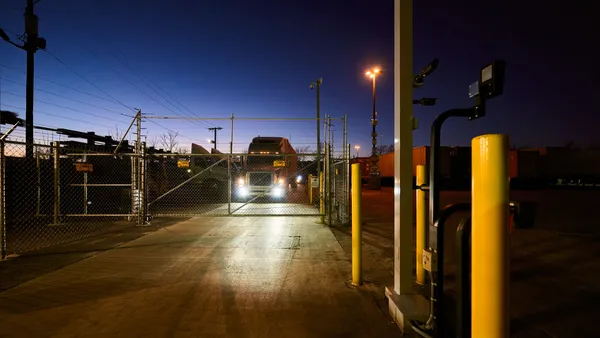Dive Brief:
- FourKites on Thursday unveiled a new real-time, temperature and location tracking solution for shippers and carriers, according to a company press release.
- The tool aims to help supply chain partners comply with Food Safety Modernization Act (FSMA) preventive control and monitoring regulations, which began to enter into effect in September, 2016.
- The Temperature Tracking tool reports temperature and location data every 15 minutes, and includes alerts for when temperatures fall outside a specified range. In addition, the solution includes a platform to visualize and analyze data over time.
Dive Insight:
Cold chain technology has long been available for food, healthcare and pharmaceutical shippers, but recent regulations have upped the ante for supply chain partners worldwide.
"FSMA has advanced the demand and requirement for shippers, 3PLs and Carriers to capture accurate temperature data," FourKites CEO and founder Mathew Elenjickal told Supply Chain Dive. "Doing so reliably is no easy task."
The increased demand provides supply chain partners an opportunity to expand their offerings. Refrigerated trucks and warehouses have been around for decades, but not without deficiencies.
A malfunction during transport of produce, whether in a truck or a shipping container, can cause food to spoil before arrival at a retailers' loading dock. Further, distinct practices among warehouses, retail storage facilities and transporters can also alter a product's lifespan.
Now, with FSMA regulations requiring monitoring capabilities and supply chain collaboration, shippers have an incentive to perform due diligence for each product. "FSMA does have considerable penalties, not the least of which [are] fines or recalls that shippers can incur," Elenjickal added.
Visibility tools like the one launched by FourKites take advantage of this increased need, and form part of what appears to be a cold chain logistics infrastructure boom. Many of the new warehouses and airport facilities being built include cold chain capacities. Meanwhile, logistics providers are increasingly investing in refrigerated equipment.
Regulations can force unanticipated costs upon an industry, but in cases like this one, they can also push multiple stakeholders to work together for greater efficiencies. An increase in real-time visibility and data analytics opportunities promises to decrease food waste and increase the raw supply available for sale in the food industry.














